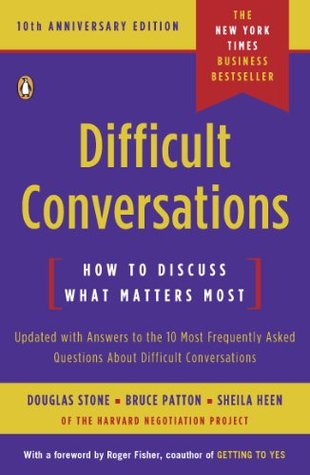More on this book
Community
Kindle Notes & Highlights
Read between
August 26 - September 8, 2023
It turns out that no matter what the subject, our thoughts and feelings fall into the same three categories, or “conversations.” And in each of these conversations we make predictable errors that distort our thoughts and feelings, and get us into trouble.
1. The “What Happened?” Conversation. Most difficult conversations involve disagreement about what has happened or what should happen. Who said what and who did what? Who’s right, who meant what, and who’s to blame?
2. The Feelings Conversation. Every difficult conversation also asks and answers questions about feelings. Are my feelings valid? Appropriate? Should I acknowledge or deny them, put them on the table or check them at the door? What do I do about the other person’s feelings? What if they are angry or hurt?
3. The Identity Conversation. This is the conversation we each have with ourselves about what this situation means to us. We conduct an internal debate over whether this means we are competent or incompetent, a good person or bad, worthy of love or unlovable. What impact might it have on our self-image and self-esteem, our future and our well-being? Our answers to these questions determine in large part whether we feel “balanced” during the conversation, or whether we feel off-center and anxious.
As you begin to sense the implications of the conversation for your self-image, you may begin to lose your balance.
Just knowing that the Identity Conversation is a component of difficult conversations can help. And, as in the other two conversations, you can do much better than mere awareness.
And at each step, there is an opportunity for different people’s stories to diverge. Where Our Stories Come From Put simply, we all have different stories about the world because we each take in different information and then interpret this information in our own unique ways.
In difficult conversations, too often we trade only conclusions back and forth,
The And Stance is based on the assumption that the world is complex, that you can feel hurt, angry, and wronged, and they can feel just as hurt, angry, and wronged. They can be doing their best, and you can think that it’s not good enough. You may have done something stupid, and they will have contributed in important ways to the problem as well. You can feel furious with them, and you can also feel love and appreciation for them.
About each of those things, you are right. But here’s the rub: that’s not what the conversation is really about.
In fact, the And Stance is probably the most powerful place to stand when engaging in a difficult conversation that requires you to deliver or enforce bad news. If you are breaking up with someone, it allows you to say “I’m breaking up with you because it’s the right thing for me [here’s why], and I understand how hurt you are, and that you think we should try again, and I’m not changing my mind, and I understand that you think I should have been more clear about my confusion earlier, and I don’t think that makes me a bad person, and I understand that I’ve done things that have hurt you, and I
...more
Intentions strongly influence our judgments of others: If someone intended to hurt us, we judge them more harshly than if they hurt us by mistake.
Much of the first mistake can be traced to one basic error: we make an attribution about another person’s intentions based on the impact of their actions on us.
In an essay in her book, Sister Outsider, poet and activist Audre Lorde pondered the question of expression and entitlement shortly after she learned she had breast cancer: I have come to believe… . that what is most important to me must be spoken, made verbal and shared, even at the risk of having it bruised or misunderstood… .
You are entitled to express yourself. If you do not believe this to your core then you’ve got some work to do.
There’s no better place to begin your story than with what is at the very heart of the matter for you: “For me, what this is really about is… . What I’m feeling is… . What is important to me is… .”
This is unfortunately all too typical of many difficult conversations. We say the least important things, sometimes over and over again, and wonder why the other person doesn’t realize what we really think and how we really feel. As you embark upon a difficult conversation, ask yourself, “Have I said what is at the heart of the matter for me? Have I shared what is at stake?” If not, ask yourself why, and see if you can find the courage to try.
Say What You Mean: Don’t Make Them Guess
One way we often skirt sharing things that are important to us is by embedding them in the subtext of the conversation rather...
This highlight has been truncated due to consecutive passage length restrictions.
Me-Me And statements sound like this: I do think you are bright and talented, and I think you’re not working hard enough. I feel badly for how rough things have been for you, and I’m feeling disappointed in you.


